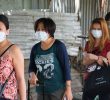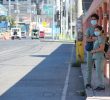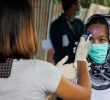DAVAO CITY, Philippines – Local health officials in Davao Region may consider lifting the enhanced community quarantine after a thorough study of the cases and statistics on coronavirus (COVID-19) in this region.
Dr. Leopoldo Vega, Director of the Southern Philippines Medical Center (SPMC) which handles all COVID-19 cases in the city, said that the coronavirus may have been controlled in a certain way based on statistics where cases of infection peaked on March 21 and have decline to zero cases in the second week of April.
The report of the Department of Health Davao Region (DOH-11) on Monday, April 13, showed COVID-199 cases remained steady at 90 for two days, with 14 deaths and 52 cases of recoveries.
Vega pointed out the recoveries can be attributed to the patient’s health status, age and no comorbidities or presence of another disease.
“The median age of recovered patients, at present is 42 years old with 72 as the oldest and four as the youngest. They exhibited mild to moderate symptoms of COVID-19 with a healthy, young profile and no-co-morbidities,” Vega said.
The SPMC has housed 74 of the patients and 41 of them have recovered.
Assistant Regional Director of the Department of Health Davao Region Dr. Lenny Joy Rivera pointed out that recoveries are managed easily because cases are early detected and were given early intervention.
The comorbidities leading to the deaths of patients are varied. Vega said of the 14 deaths, the oldest who is 75 years old died due to poor kidney function and the youngest at 18 had cancer.
With these statistics, Vega said that the enhanced community quarantine helped in a way flattened and plateaued COVID-19 cases in the region for several days, with zero new cases, fewer deaths, fewer patients and more recoveries.
Previously, health officials estimated the peak of COVID-19 cases would have been this second week of April.
Davao Region was placed on community quarantine on March 15 and was raised to enhanced community quarantine on April 4 until April 19.
But Vega and Rivera cautioned not to hasten the lifting of the quarantine.
“We cannot automatically switch. There has to be a graduated lifting on the quarantine. We need to meet certain conditions before we can decide on lifting it,” Vega said.
“We can say that we are COVID-19 free or have contained the virus if there is a consistent decline to zero positive COVID-19 results. There is a need to study the data because there are times that cases will again show up after a time of zero cases,” Rivera explained.(davaotoday.com)










